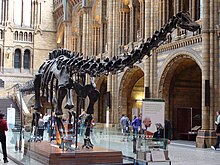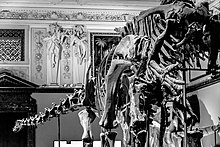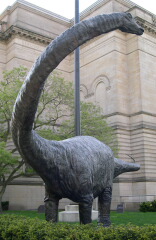Dippy
 | |
| Catalogno. | CM 84 |
|---|---|
| Common name | Dippy |
| Species | Diplodocus carnegii |
| Age | 145–156 Ma[1] |
| Place discovered | Sheep Creek Quarry D, nearMedicine Bow, Wyoming;upper 10 m (33 ft) of the Talking Rock facies of the Brushy Basin Member of theMorrison Formation |
| Date discovered | July 4, 1899 |
| Discovered by | William Harlow Reed |
Dippyis a compositeDiplodocusskeleton inPittsburgh'sCarnegie Museum of Natural History,and theholotypeof thespeciesDiplodocus carnegii.It is considered the most famous single dinosaur skeleton in the world, due to the numerousplaster castsdonated byAndrew Carnegieto several major museums around the world at the beginning of the 20th century.[2][3]
The casting and distribution of the skeleton made the worddinosaura household word;[4]for millions of people it became the first dinosaur they had ever seen.[5]It was also responsible for the subsequent popularity of the entire genusDiplodocus,since the skeleton has been on display in more places than any othersauropoddinosaur.[6]
Its discovery was catalyzed by the announcement of the excavation of a large thigh bone (unrelated to Dippy) by William Harlow Reed nearMedicine Bow, Wyomingin December 1898.[7]On a return trip financed by Carnegie, Reed excavated Sheep Creek Quarry D in which he found the first part of Dippy's skeleton, a toe bone, on July 4, 1899.[8]Its discovery onIndependence Day,and its use in American diplomacy via Carnegie's international donations of replicas, led to its being nicknamed the "star-spangled dinosaur".[9]Dippy became the centrepiece of the Carnegie Museum of Natural History, such that the museum became known as "the house that Dippy built".[4][10]
In 2016, a petition to theInternational Commission on Zoological Nomenclaturewas being considered which proposed to makeDiplodocus carnegiithe newtype speciesofDiplodocus.[11]The proposal was rejected in 2018, andD. longushas been maintained as the type species.[11][12]
Discovery
[edit]
The skeleton was found in the upper 10 metres (33 ft) of the Talking Rock facies of the Brushy Basin Member of theMorrison Formation,inAlbany County, Wyoming.[14]
In 1900,John Bell Hatcherwas hired byWilliam Jacob Hollandas curator of paleontology and osteology for theCarnegie Museum of Natural History,succeedingJacob Lawson Wortman.[7]Hatcher supervised the field expeditions, excavations, investigation and display of Dippy, and named the species for Carnegie.[7]Hatcher's monograph on the find was published in 1901 asDiplodocus Marsh: Its Osteology, Taxonomy, and Probable Habits, with a Restoration of the Skeleton.[7]
It is a composite skeleton comprising:[15]
- CM 84: the majority of the skeleton, namedDiplodocus carnegii,and published in 1901 by Hatcher
- CM 94: supplemented missing bones
- CM 307: the tail
- CM 662 and USNM 2673: skull elements. In 2015, the USNM skull was recategorized asGaleamopus,along with several otherDiplodocusskulls, leaving no definiteDiplodocusskulls known.[16]
- some foot and limb bones of aCamarasaurus
Pittsburgh display
[edit]
The original skeleton has been on display at theCarnegie Museum of Natural Historysince April 1907, two years after the first cast was shown. The delay was due to construction work at the Pittsburgh museum, which needed expansion in order to house Dippy.[17]Today, the skeleton is part of theDinosaurs in Their Timeexhibition.[18]
Casts
[edit]Background
[edit]IndustrialistAndrew Carnegiefinanced the acquisition of the skeleton in 1898, as well as the donation of the casts at the beginning of the 20th century.[19][20]His great-grandson, William Thomson, was quoted in 2019 explaining the donations: "By gifting copies to the heads of state of seven other countries as well as the UK, Carnegie hoped to demonstrate through mutual interest in scientific discoveries that nations have more in common than what separates them. He used his gifts in an attempt to open inter state dialogue on preserving world peace – a form of Dinosaur diplomacy."[21]
London cast
[edit]
The London cast of Dippy came about when KingEdward VII,then a keen trustee of theBritish Museum,saw a sketch of the bones at Carnegie's Scottish home,Skibo Castle,in 1902, and Carnegie agreed to donate a cast to the Natural History Museum as a gift. Carnegie paid £2,000 for the casting inplaster of paris,copying the original fossil bones held by the Carnegie Museum (not mounted until 1907, as a new museum building was still being constructed to house it).[22] The 292 cast pieces of the skeleton were sent to London in 36 crates, and the 25.6 metres (84 ft) long exhibit was unveiled on May 12, 1905, to great public and media interest, with speeches from the museum director ProfessorRay Lankester,Andrew Carnegie,Lord Aveburyon behalf of the trustees, the director of the Carnegie MuseumWilliam Jacob Holland,and finally the geologist SirArchibald Geikie.The cast was mounted in the museum's Reptile Gallery to the left of the main hall (until recently the gallery of Human Biology) as it was too large to display in the Fossil Marine Reptile Gallery (to the right of the main hall).[23][24]
Dippy was taken to pieces and stored in the museum's basement during the Second World War to protect it frombomb damage,and reinstalled in the Reptile Gallery after the war. The original presentation of the cast was altered several times to reflect changes in scientific opinion on the animal's stance. The head and neck were originally posed in a downwards position, and were later moved to a more horizontal position in the 1960s.[25]
Dippy was removed from the Reptile Gallery in 1979 and repositioned as the centrepiece of the main central hall of the museum, later renamed the Hintze Hall in recognition of a large donation byMichael Hintze.[25]Dippy replaced a mountedAfrican elephant,nicknamed George, which had been on display as the central exhibit in the main hall since 1907, with various other animal specimens. The elephant had itself replaced the skeleton of asperm whalewhich was the first significant exhibit in the hall and had been on display since at least 1895: earlier, the hall had been left largely empty. Dippy was originally displayed alongside a cast of aTriceratopsskeleton, which was removed around 1993. The tail of theDiplodocuscast was also lifted to waft over the heads of visitors; originally it drooped to trail along the floor.[26]
The cast became an iconic representation of the museum. After 112 years on display at the museum, the dinosaur replica was removed in early 2017 to be replaced by the 25 m (82 ft) long skeleton of a youngblue whale,dubbed "Hope". The work involved in removing Dippy and replacing it with the whale skeleton was documented in aBBCTelevision special,Horizon:Dippy and the Whale,narrated byDavid Attenborough,which was first broadcast onBBC Twoon July 13, 2017, the day before the whale skeleton was unveiled for public display.[27]
Dippy started a tour of British museums in February 2018, mounted on a new, more mobile armature.[28][29]Dippy is and has been on display at locations around the United Kingdom:Dorset County Museum(February 10 – May 7, 2018),[30]Birmingham Museum and Art Gallery(26 May – September 9, 2018),[31]Ulster Museum(September 17, 2018 – January 6, 2019),[32]Kelvingrove Art Gallery and Museum,theGreat North Museum,theNational Museum of Wales,Number One Riversidein Rochdale, andNorwich Cathedral.[33]
Other casts
[edit]As director of the Carnegie Museums, William Holland supervised the donations of the casts. His trip to Argentina in 1912 was recorded by Holland in his 1913 travel bookTo the River Plate and Back.Holland noted a poem which had become popular among college students:[23][34]
Crowned heads of Europe
All make a royal fuss
Over Uncle Andy
And his old diplodocus.
Known casts include:
| Date | Location | Material | Description | Image |
|---|---|---|---|---|
| May 12, 1905 | Natural History Museum,London | Plaster cast | The first cast. Removed 2017. Further details atDippy (London). | 
|
| May 1908 | Museum für Naturkunde,Berlin | Plaster cast | 
| |
| June 15, 1908 | French National Museum of Natural History,Paris | Plaster cast | 
| |
| 1909 | Natural History MuseuminVienna,Austria | Plaster cast | 
| |
| 1909 | Giovanni Capellini Museum for Paleontology and GeologyinBologna,Italy | Plaster cast | Skulls from this cast (i.e., 'second-generation') are on display in museums inMilanandNaples. | 
|
| 1910 | Zoological Museum of the Russian Academy of SciencesinSt. Petersburg,Russia | Plaster cast | Cast later moved toMoscow Paleontological Museum.[35] | 
|
| 1912 | Museo de la PlatainLa PlatanearBuenos Aires,Argentina | Plaster cast | The caster was donated to the country via presidentSaenz Peñaand mounted byW. J. Holland | 
|
| November 1913[36] | National Natural History MuseuminMadrid,Spain | Plaster cast | 
| |
| 1930 | Museo de Paleontología in Mexico City | Plaster cast | 
| |
| 1932 | Paleontological MuseuminMunich,Germany | Plaster cast | Donated in 1932, but still unmounted. | |
| 1989 | Utah Field House of Natural History State Park Museum | Fibreglass and polyester cast | 
| |
| 1999 | Carnegie Museum of Natural History(outside) | Fibreglass cast | Outside the building in which the original skeleton is displayed; further details atDippy (statue). | 
|
Pittsburgh statue
[edit]
In 1999 a public sculpture of Dippy was unveiled on the grounds of theCarnegie Institute and Library complexin theOaklandneighborhood ofPittsburgh, Pennsylvania,in tribute to the 100th anniversary of the discovery of Dippy. The dark, grayish brown life-size fiberglass model weighs 3,300 pounds (1,500 kg), stands 22 feet (6.7 m), and measures 84 feet (26 m) in length. The sculpture was created during a nine-month process from the original fossil. Sited alongForbes AvenuenearSchenley Plazaand the lawn of theUniversity of Pittsburgh'sCathedral of Learning,Dippy stands adjacent to the entrances of the Carnegie Music Hall and theCarnegie Museum of Natural History.[37][38]
In addition to its service as a mascot for the museum,Dippyhas been seen sporting theTerrible Towelof thePittsburgh Steelersand the colors of University of Pittsburgh'sathletic teams.Sometimes when it's cold out the staff dresses him up with a gigantic scarf.[39]Dippy is a featured Pittsburgh landmark onYinztagram.[40]
Gallery
[edit]-
John Bell Hatcher's 1901lithographof Dippy, from the first issue ofMemoirs of the Carnegie Museum of Natural History
-
1905 unveiling of thecast in London
-
1905 (24 May)Punchcartoon byEdward Tennyson Reedof Dippy with Natural History Museum directorRay Lankester
-
1905 (June 4)New York Timescoverage of the London cast
-
1908, at the Carnegie Museum in Pittsburgh
-
1908 work on the cast of Dippy in Paris; Arthur Goggeshall and William Holland at front center
-
1922 image fromH. G. Wells'sA Short History of the World
See also
[edit]References
[edit]- ^Dippy: this is your life,Natural History Museum, Matthew Prosser, January 1, 2016
- ^Ulrich Merkl 2015,p. 78 "Although it narrowly failed to win the race with the New York Museum of Natural History in 1905, theDiplodocus carnegiiis the most famous dinosaur skeleton today, due to the large number of casts in museums around the world "
- ^Breithaupt, 2013, p. 49: "" Dippy "was and still is the most widely seen and best-known dinosaur ever found."
- ^abMoore 2014,p. 117.
- ^Rea 2004,p. 11.
- ^"Diplodocus."In: Dodson, Peter & Britt, Brooks & Carpenter, Kenneth & Forster, Catherine A. & Gillette, David D. & Norell, Mark A. & Olshevsky, George & Parrish, J. Michael & Weishampel, David B.The Age of Dinosaurs.Publications International, Ltd. pp. 58–59.ISBN0-7853-0443-6.
- ^abcdLowell Dingus 2018,pp. 290–291.
- ^Breithaupt, 2013, p. 49
- ^Ulrich Merkl 2015,p. 80.
- ^Krishtalka, Leonard (May 16, 2018).The Bone Field.Gatekeeper Press. pp. 58–.ISBN978-1-64237-016-4.
- ^abTschopp, E.; Mateus, O. (2016). "Diplodocus Marsh, 1878 (Dinosauria, Sauropoda): proposed designation of D. carnegii Hatcher, 1901 as the type species".Bulletin of Zoological Nomenclature.73(1): 17–24.doi:10.21805/bzn.v73i1.a22.S2CID89131617.
- ^ICZN. (2018). "Opinion 2425 (Case 3700) –DiplodocusMarsh, 1878 (Dinosauria, Sauropoda):Diplodocus longusMarsh, 1878 maintained as the type species ".Bulletin of Zoological Nomenclature.75(1): 285–287.doi:10.21805/bzn.v75.a062.S2CID92845326.
- ^Breithaupt, 2013, p. 48
- ^Brezinski and Kollar
- ^Breithaupt, 2013, p. 49: "The first (CM 84) would become the type ofD. carnegii( "Carnegie's double-beamed reptile" ) described by Hatcher in 1901. The second (CM 94) supplemented the missing bones of the first. Eventually, the tail (CM 307) and skull elements (CM 662 and USNM 2673) ofDiplodocusspecimens from other areas were used to complete the skeleton, as well as the foot and limb bones ofCamarasaurus."
- ^Tschopp, E.; Mateus, O. V.; Benson, R. B. J. (2015)."A specimen-level phylogenetic analysis and taxonomic revision of Diplodocidae (Dinosauria, Sauropoda)".PeerJ.3:e857.doi:10.7717/peerj.857.PMC4393826.PMID25870766.
- ^Rea 2004,pp. 198–199.
- ^Carnegie NHM,The Two-Headed DinosaurArchivedJune 9, 2020, at theWayback Machine,July 11, 2018
- ^Rea, 2001, pp. 1–11 and 198–216.
- ^Lowell Dingus 2018,p. 410.
- ^Dippy, ‘the UK’s most famous dinosaur’, arrives at Kelvingrove Museum,January 22, 2019
- ^Rea 2004,p. 3, 163–164.
- ^abHolland, W. J. (1913).To the River Plate and Back. The narrative of a scientific mission to South America, with observations on things seen and suggested.New York & London: G. P. Putnam's Sons.
- ^Rea 2004,p. 10.
- ^abThe Telegraph,The life story of Dippy the dinosaur
- ^Natural History Museum,A history in pictures: the Museum’s Hintze Hall
- ^"Dippy and the Whale".DocuWiki. July 15, 2017.
- ^McVeigh, Tracy (January 1, 2017)."Dippy's last days: diplodocus leaves London after 112 years for farewell UK tour".The Observer.
- ^Fuller, George (January 4, 2017)."Dippy the Diplodocus bids farewell to his public at the Natural History Museum".The Daily Telegraph.
- ^"Dorset County Museum".
- ^"Dippy on Tour: A Natural History Adventure".birminghammuseums.org.uk.Archived fromthe originalon May 25, 2018.RetrievedMay 25,2018.
- ^"'Dippy' the Dinosaur begins epic journey to Belfast ".Belfasttelegraph.co.uk.
- ^Dinosaur on tour: host venues for Dippy the diplodocus announced,The Guardian, November 15, 2016
- ^Nieuwland, Ilja (2010). The colossal stranger. Andrew Carnegie andDiplodocusintrude European Culture, 1904–1912.Endeavour34(26).
- ^Rea, 2004, p. 217
- ^Pérez-Garcia, Adán; Sánchez Chillón, B. "Historia de Diplodocus carnegii del MNCN: primer esqueleto de dinosaurio en la Peninsula Iberica".Revista Española de Paleontologiá.24(2): 133–148.
- ^Pittsburgh Post Gazette,Hip dinosaur Dippy, Oakland’s trendy dinosaur,June 25, 2014
- ^Bob Batz, Jr. (1999).Dippy the dinosaur sculpture installation: story from thePittsburgh Post-GazetteArchivedJune 29, 2011, at theWayback Machine
- ^"Dippy Sides with the Panthers"(PDF).Pitt Chronicle.Vol. 10, no. 31. University of Pittsburgh. November 16, 2009. p. 2.RetrievedNovember 16,2009.
- ^"Yinztagram By Pegula".iTunes Store.Apple Inc.2012. Archived fromthe originalon August 28, 2012.RetrievedDecember 13,2012.
Bibliography
[edit]Editio princeps
[edit]Secondary sources
[edit]- Ilja Nieuwland (April 30, 2019).American Dinosaur Abroad: A Cultural History of Carnegie's Plaster Diplodocus.University of PITTSBURGH Press.ISBN978-0-8229-4557-4.
- Rea, Tom (April 1, 2004).Bone Wars: The Excavation and Celebrity of Andrew Carnegie's Dinosaur.University of Pittsburgh Pre.ISBN978-0-8229-7258-7.
- Lowell Dingus (December 4, 2018).King of the Dinosaur Hunters: The Life of John Bell Hatcher and the Discoveries that Shaped Paleontology.Pegasus Books.ISBN978-1-68177-930-0.
- Brezinski, D. K., & Kollar, A. D. (2008),Geology of the Carnegie Museum dinosaur quarry site of Diplodocus carnegii,Sheep Creek, Wyoming. Annals of Carnegie Museum, 77(2), 243–252.
- Ulrich Merkl (November 25, 2015).Dinomania: The Lost Art of Winsor McCay, The Secret Origins of King Kong, and the Urge to Destroy New York.Fantagraphics Books.ISBN978-1-60699-840-3.
- Breithaupt, Brent H,The discovery and loss of the “colossal” Brontosaurus giganteus from the fossil fields of Wyoming (USA) and the events that led to the discovery of Diplodocus carnegii: the first mounted dinosaur on the Iberian Peninsula,VI Jornadas Internacionales sobre Paleontología de Dinosaurios y su Entorno, September 5–7, 2013, pp. 48–50
- Moore, Randy (July 23, 2014).Dinosaurs by the Decades: A Chronology of the Dinosaur in Science and Popular Culture: A Chronology of the Dinosaur in Science and Popular Culture.ABC-CLIO.ISBN978-0-313-39365-5.
External links
[edit]- Dippy at the Carnegie Museum of Natural HistoryArchivedAugust 4, 2021, at theWayback Machine
- Diplodocus: this is your life,Natural History Museum
- Dippy on Tour,Natural History Museum
- Taking Dippy down: the first steps,Natural History Museum
- Natural History Museum unveils 'Dippy' the Diplodocus replacement Hope the blue whale,The Independent,July 14, 2017
- Bone Wars: The Excavation and Celebrity of Andrew Carnegie's Dinosaur,Tom Rea, pp. 1–11
- Bob Batz, Jr. (1999).Dippy the dinosaur sculpture installation: story from thePittsburgh Post-GazetteArchivedJune 29, 2011, at theWayback Machine.Retrieved May 16, 2007.
- Rea, Tom (2001).Bone Wars: The Excavation and Celebrity of Andrew Carnegie's Dinosaur.Pittsburgh: University of Pittsburgh Press.ISBN0-8229-4173-2.







